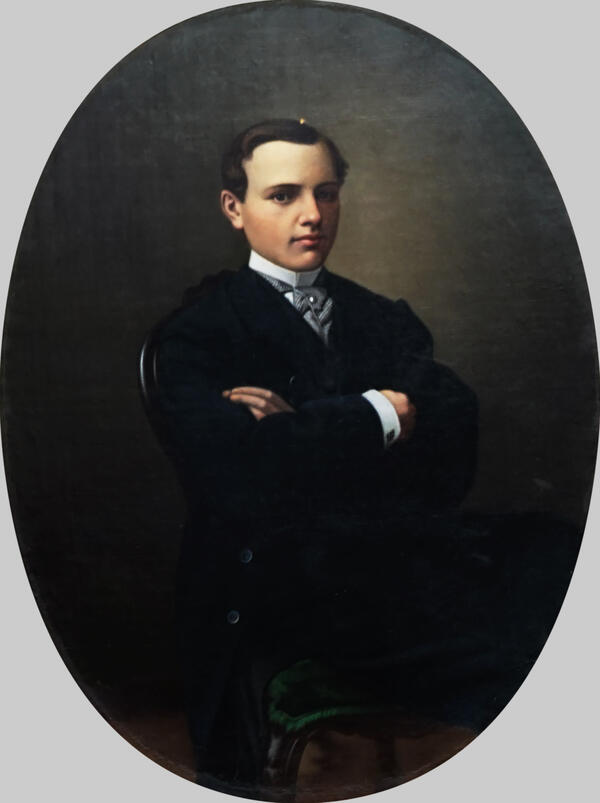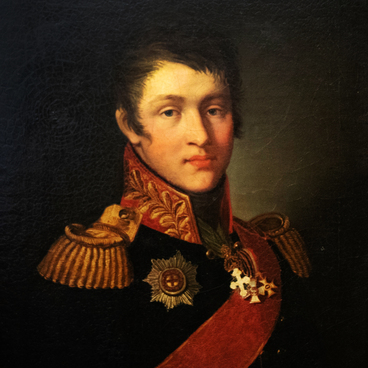The painting portrays an elegantly and impeccably dressed 19-year-old boy. He is wearing a dark frock coat and a gray checkered necktie. The necktie is tied in a special way to form a soft bow, as was the fashion among the aristocrats at the time. A pin with a large pearl adorns the bow, while the cuffs of Talyzin’s snow-white men’s shirt are fastened with cufflinks.
MikhaIl Talyzin graduated from the Corps of Pages at the age of twenty. After graduation, he became a gentleman of the bedchamber of His Majesty’s Court, as well as a regular member of Moscow’s provincial office. He served as a member of Moscow’s provincial office for peasant affairs. Mikhail Talyzin also was the chief commissioner of the Red Cross Society during the Russo-Turkish War of 1877–1878.
He was decorated with the Order of Saint Vladimir, fourth class. He had a court rank of chamberlain.
Mikhail Talyzin grew up in the Denezhnikovo estate, which is located in the Bronnitsy District. The estate belonged to the Talyzin family, who at the time still had the status of noblemen of ancient standing. Judging by historical documents, the family tree of Mikhail Alexandrovich goes all the way back to the 15th century, with names of its members being found in accounts of many significant events in the history of the Russian state. The family originates from murza of the Golden Horde Kuchuk Bey-Tagaldy-zin, who was baptised as Yakov.
The estate ensemble of Denezhnikovo was built by a member of the Admiralty Board since 1748, admiral Ivan Lukyanovich Talyzin (1700–1779). Ivan Lukyanovich was a relative of Nikita Ivanovich Panin, a diplomat in charge of the Russian foreign policy. Another relative of Ivan Talyzin was the Chancellor of the Russian Empire Alexey Petrovich Bestuzhev-Ryumin.
It was he who famously replied to the envoys of Peter III that they should “leave the way they came, for he had not seen any Emperor of Russia, and serves faithfully only to the sole Empress of All Russia, Catherine II.”
Eventually, Denezhnikovo passed on to Ivan Lukyanovich’s male heir, Alexander Fyodorovich Talyzin (1731–1787). He was promoted to lieutenant captain, then to captain; he was a gentleman of the bedchamber of the Imperial Court, then a secret councilor, senator, and chamberlain; he was decorated with the highest orders, and had a distinct honor of wearing a diamond epaulette on his left shoulder.
Alexander Talyzin played a prominent role in the plot to overthrow Peter III and crown Catherine the Great. The Empress entered Petersburg disguised in Talyzin’s uniform. This uniform was kept as an heirloom by the Apraksin family first in the village of Olgovo in the Moscow Province, and then in Denezhnikovo. Currently, the uniform is contained in the collection of the State Historical Museum.
MikhaIl Talyzin graduated from the Corps of Pages at the age of twenty. After graduation, he became a gentleman of the bedchamber of His Majesty’s Court, as well as a regular member of Moscow’s provincial office. He served as a member of Moscow’s provincial office for peasant affairs. Mikhail Talyzin also was the chief commissioner of the Red Cross Society during the Russo-Turkish War of 1877–1878.
He was decorated with the Order of Saint Vladimir, fourth class. He had a court rank of chamberlain.
Mikhail Talyzin grew up in the Denezhnikovo estate, which is located in the Bronnitsy District. The estate belonged to the Talyzin family, who at the time still had the status of noblemen of ancient standing. Judging by historical documents, the family tree of Mikhail Alexandrovich goes all the way back to the 15th century, with names of its members being found in accounts of many significant events in the history of the Russian state. The family originates from murza of the Golden Horde Kuchuk Bey-Tagaldy-zin, who was baptised as Yakov.
The estate ensemble of Denezhnikovo was built by a member of the Admiralty Board since 1748, admiral Ivan Lukyanovich Talyzin (1700–1779). Ivan Lukyanovich was a relative of Nikita Ivanovich Panin, a diplomat in charge of the Russian foreign policy. Another relative of Ivan Talyzin was the Chancellor of the Russian Empire Alexey Petrovich Bestuzhev-Ryumin.
It was he who famously replied to the envoys of Peter III that they should “leave the way they came, for he had not seen any Emperor of Russia, and serves faithfully only to the sole Empress of All Russia, Catherine II.”
Eventually, Denezhnikovo passed on to Ivan Lukyanovich’s male heir, Alexander Fyodorovich Talyzin (1731–1787). He was promoted to lieutenant captain, then to captain; he was a gentleman of the bedchamber of the Imperial Court, then a secret councilor, senator, and chamberlain; he was decorated with the highest orders, and had a distinct honor of wearing a diamond epaulette on his left shoulder.
Alexander Talyzin played a prominent role in the plot to overthrow Peter III and crown Catherine the Great. The Empress entered Petersburg disguised in Talyzin’s uniform. This uniform was kept as an heirloom by the Apraksin family first in the village of Olgovo in the Moscow Province, and then in Denezhnikovo. Currently, the uniform is contained in the collection of the State Historical Museum.



